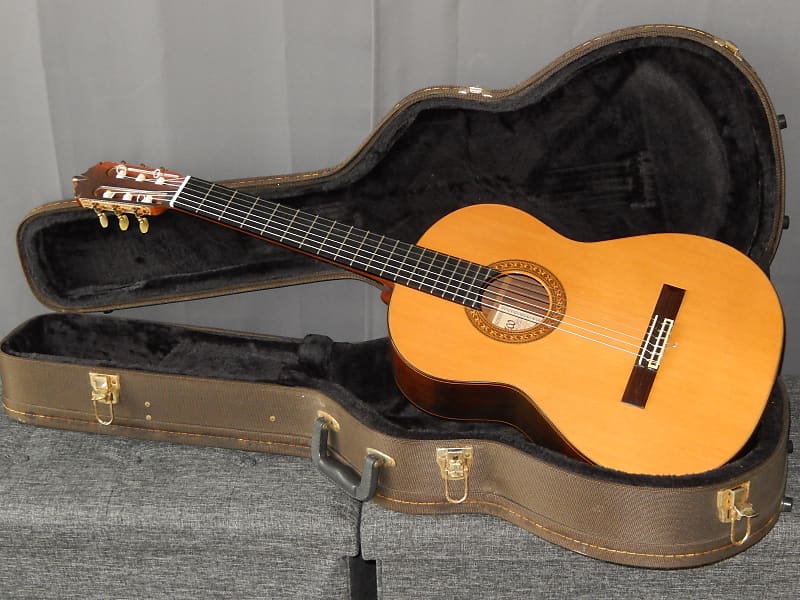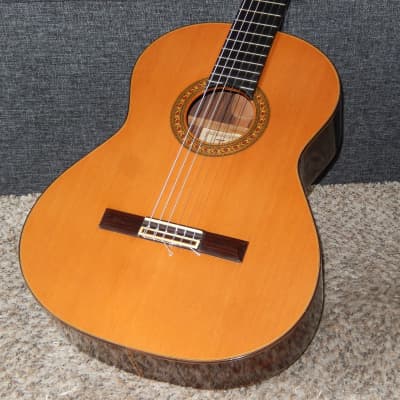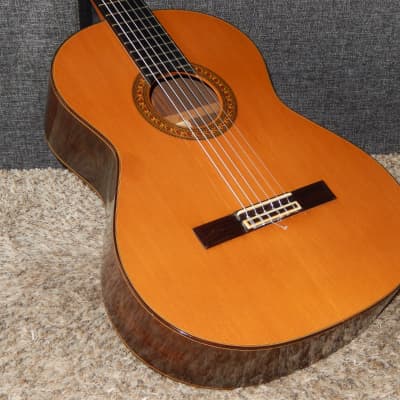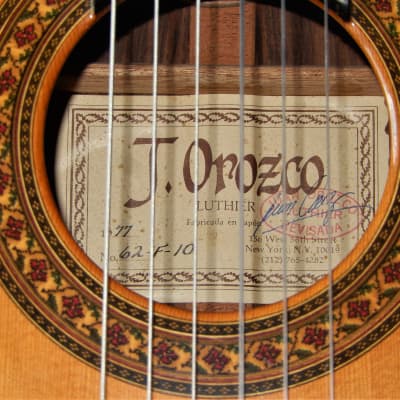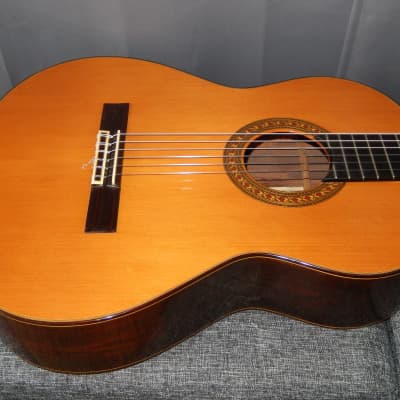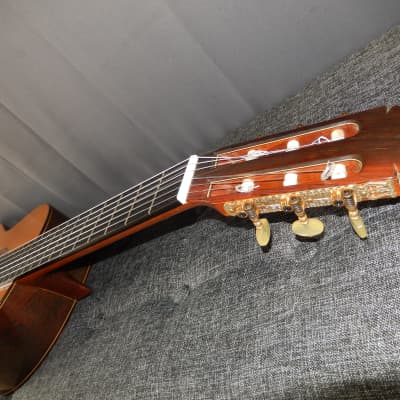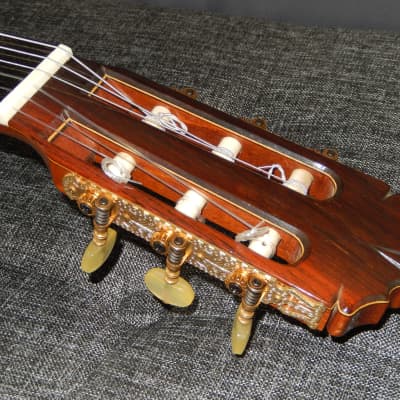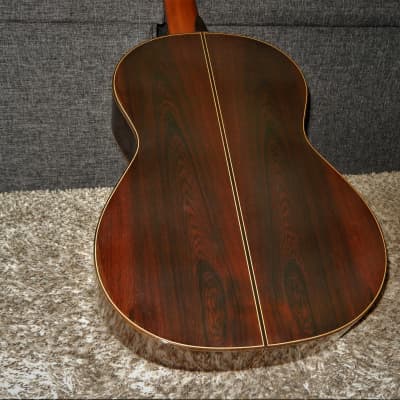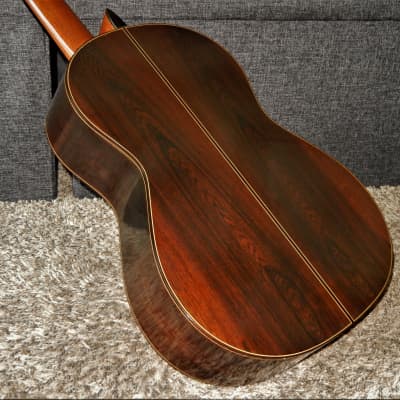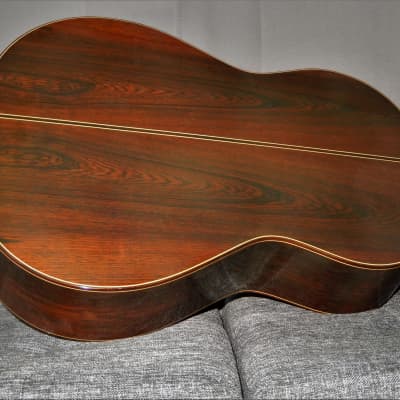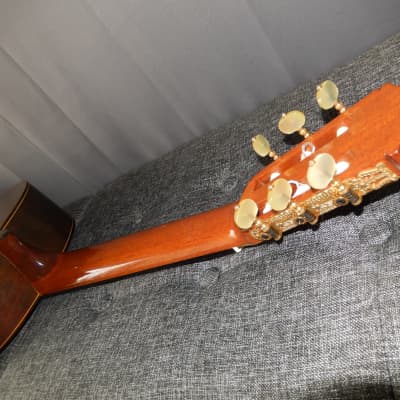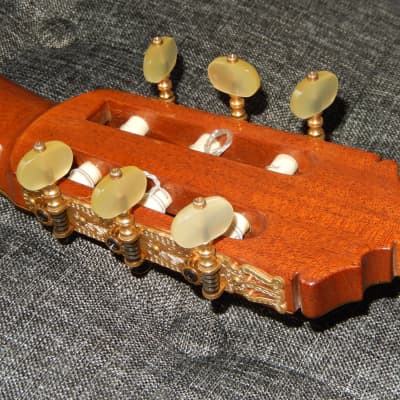Several hundred guitars I have sold in the past are presented at Facebook.com/Victors.Guitar.Library.
Juan Orozco model 62-F-10 1977
Guitar you are looking at was made in Japan in 1977. It is unclear who was its actual maker.
According to Juan Orozco’s published statements, he cooperated with several Japanese makers since 1969 through early 1980s. He mentioned names Tamura, Matsuoka, Yairi and workshops Takamine and Hoshino Gakki. Hoshino Gakki and Takamine Gakki were closely cooperating with Masaru Kohno workshop. Some Juan Orozco models made by Hoshino Gakki luthiers were exact copies of Kohno guitars.
This guitar is certainly not a copy of Kohno guitars. Its scale, Cedar top, construction method and material selection suggest that it was most likely made by Hiroshi Tamura. Hiroshi has mastered “double back” construction and used it to make his P80 and P100 models (sold in early/mid1970s). This guitar most likely is made the same way.
If you decide to search the internet you will find some info describing Juan Orozco’s story and achievements. You will also find several reviews describing the quality of his guitars, sold in many countries. I have summarized this available info into a brief chapter.
Juan Orozco III (born on April 14th, 1937 and died February 15th 2020) was a Spanish luthier and guitar impresario who lived in New York from 1965 to 1995, where he had a famous guitar shop at 56th Street (in the vicinity of Carnegie Hall). This address was actually the third location of Juan’s guitar shop. Since 1960s his shop was moved twice to new locations. Juan was also known as the maker of Aranjuez guitar strings and guitar cases. He was also known as organizer of guitar concerts. He befriended many other luthiers and guitar virtuosos.
Juan was the third generation in family of guitar makers. Juan’s father (Juan Orozco II) built guitars in Spain, Uruguay and Brazil and his son was also actively involved in these workshops.
Between 1969 and 1983 Juan Orozco closely cooperated with several famous Japanese luthiers (Ryoji Matsuoka, Hiroshi Tamura, Sadao Yairi, Masaru Kohno, Masaki Sakurai, Takamine Gakki and Hoshino Gakki. (Gakki in Japanese means Musical Instruments Company).
Guitar you are looking at was a part of Juan’s personal guitar collection. I was fortunate enough to purchase it directly from Juan’s son.
This instrument represents very high grade among all Japanese made Cedar top classical guitars. It certainly belongs to the high shelf among world class instruments.
It offers great volume, super response and sweet and romantic (Spanish) tonality. Despite being made with Cedar top it offers exceptional treble note clarity, almost Spruce-like. Basses are relatively deep, almost metallic, rich with overtones yet quite clean at the same time. All notes are very well separated. While chords are played you get a great feeling of transparency.
Brand new Spanish made guitars of that grade are priced minimum $5000.
Very importantly this guitar is set with already lower than standard (for classical guitars) action, which still can be lowered if you wish. This is hardly achievable on most vintage guitars.
Overall condition of this guitar can be described as “excellent for its age”. While its body bears several minor cosmetic flaws (few small dents and several relatively light scratches on the soundboard, some “haze” and hair like scratches on the pack plate and sides) guitar is structurally sound, its neck is straight, fingerboard and leveled frets remain in excellent condition. Original tuners work fine. Mild cloudiness of its finishes is greatly exaggerated on the pictures. The only non-original part is nut, which I have custom made for this guitar. With my “legendary” set up guitar is super comfortable to play.
Specifications:
Top: Very High Grade Solid Cedar /ultra thin coat of urethane
Back & Sides: “non-solid” Brazilian Rosewood /thin coat of urethane
Neck: Mahogany
Fingerboard: Ebony
Scale: 650 mm
Nut width: 52 mm
The action on this guitar is set to 3.50 mm under E6 and 3.00 mm under E1, with plenty of extra room on the saddle.
Guitar will be shipped in used hard shell case in still very good condition on the inside and “less than great” on the outside.
When contemporary Japanese luthiers are using 40+ years old soundboards to make “all solid woods” guitar it is priced at least $5000USD. Guitars with artificially aged (“baked”) soundboards are priced at least $4500USD. Solid top models with 40+ years old soundboards are priced at least $3500USD. American, Australian and European luthiers usually charge 50% more.
It is a matter of basic education (not beliefs) to realize that 50+ years old soundboard of this guitar alone is worth $2500USD.
The key to understand value of vintage Japanese guitars is to acknowledge galloping price inflation (devaluation of Japanese yen) during 1960s & 1970s. This inflation slowed down in 1980s.
During 1960s and most of 1970s model numbers of Japanese guitars were strictly interconnected with their prices in Japanese yen. By early 1980s and during following decades model numbers were no longer strictly associated with their prices. Some Japanese guitar makers introduced model names instead of model numbers. Others were still using model numbers with addition of letters and/or other symbols.
It is then important to understand that two Yamaha GC10 guitars made 10 years apart are two instruments of totally different class. The same applies to any other Japanese maker/brand.
The logical way to estimate the true class of any given Japanese made instrument is to compare its price with the average annual salary of wage workers in Japanese private sectors. This salary was: 450 600 yen in 1965 - 825 900 yen in 1970 - 1 868 300 yen in 1975 - 2 689 000 yen in 1980 - 3 163 000 yen in 1985 - 3 761 000 yen in 1990 - 4 107 000 yen in 1995 - 4 082 000 yen in 2000.
Any guitar priced 100 000 yen in 1970 (labelled as No10 or No100) would be priced 200 000 yen in 1975 (relabeled to No20, No200 or 2000), 300 000 yen in 1977 (labelled as No3, No30 or 3000) and 500 000 yen by 1985 (labelled as No50 or 5000).
Starting in 1977 Masaru Kohno introduced his new models No40 priced 400 000 yen and No50 priced 500 000 yen. By early 1980s Kohno started using model names instead of numbers and was steadily raising their prices without changing model labeling. His very top model 50 became model “Special”, and a decade later it became model “Maestro”. Naturally, all other Japanese guitar makers were doing similar pricing (labelling) upgrades.
Knowing all of that, you can bet on that Masaru Kohno No50 made in 1982 is practically the same grade instrument as Kohno No20 made in 1972, or Kohno no 30 made in 1975.
In early 1970s the lowest Ryoji Matsuoka (all plywood) model was 10, followed by (solid top) models 15, 20, 25, 30, 40, 50, 60, 80 and (all solid woods) models 100 and 150. Models 50, 60 and 80 were made with non-solid figured Brazilian Rosewood (double) back and sides and top model 150 was the only one made with solid figured Brazilian Rosewood b/s.
In 1980 the lowest Matsuoka model was (all plywood) 20, followed by (solid top) models 30,40,50, 60 and all solid woods models 80,100,150 and 200. By 1990 the lowest Matsuoka model was M40 and the highest was M300. By 2010 the lowest Matsuoka model was M50 and the top model was M270.
You can bet that Ryoji Matsuoka model 50 from 1980 is of the same grade as model M100 from 2000, model 100 from 1980 is of the same grade as model M150 from 2000, model 150 from 1980 is of the same grade as M200 from 2000 and model 200 from 1980 is of the same grade as model M300 from 2000.
It is important to mention that if modern era luthiers are using 40+ years old woods to make an “all solid” wood classical guitar, its price is minimum $8000.
All vintage guitars made with Brazilian Rosewood are especially precious, including those made straight grain varieties and those with non-solid b/s.
Because response and tonal properties of Spruce soundboards are improving over time, long seasoned Spruces are far more precious than long seasoned Cedars.
It is not very difficult to find out what are current prices of such guitars made by world’s leading luthiers.
Important message for Australian buyers:
USPS International Priority Mail packages destined for Australia have quite restricted size (max. length is 42” and max. length + girth is 97”). For these reasons I must use the case that is no longer than 41” and therefore it may be different than the one you see on the pictures. You should ask me for any other details prior to making a purchase.
